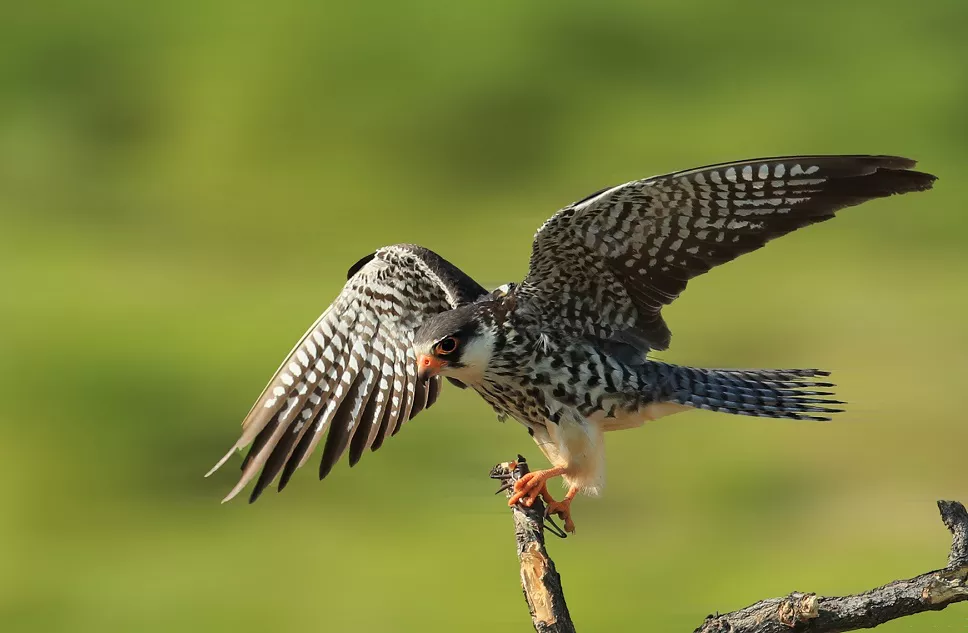The Amur Falcon, scientifically known as Falco amurensis, is a small bird of prey that breeds in Siberia and northern China and migrates to southern Africa and India during the winter months. This magnificent bird is renowned for its long-distance migration, which covers a distance of over 20,000 km each year. Despite being a relatively unknown species to the general public, the Amur Falcon has recently gained much attention due to its incredible migration story and the conservation efforts being made to protect it.
Physical Characteristics
The Amur Falcon is a small bird of prey, measuring around 30 cm in length and weighing between 100-150 grams. The male and female birds have different physical characteristics. The male has a blue-grey head and back, with a chestnut red breast and underparts. Its wings are pointed and narrow, making it an incredibly agile flyer. The female, on the other hand, is slightly larger than the male and has brownish-grey feathers throughout her body.
One of the most striking features of the Amur Falcon is its eyesight. Its large, dark eyes are well adapted for hunting, allowing it to spot prey from great distances. The bird also has strong talons and a sharp beak, which it uses to catch and kill its prey.
Migration Pattern
The Amur Falcon’s migration pattern is truly remarkable. During the breeding season, which occurs between May and September, the bird breeds in Siberia and northern China. After the breeding season, the bird embarks on its long journey southwards, crossing over the Himalayas and flying over the Indian Ocean to reach southern Africa and India.
Studies have shown that the Amur Falcon completes this incredible journey in just a few weeks, flying up to 500 km per day at an average speed of 60 km/h. During this time, the bird faces numerous challenges, including extreme weather conditions, lack of food and water, and predation.
Feeding Behavior:
During their migration, Amur Falcons exhibit a predominantly insectivorous diet. Their main prey items include flying insects, such as dragonflies, locusts, and termites. These birds are highly agile in flight, allowing them to perform impressive aerial acrobatics as they pursue their prey. Amur Falcons often congregate in large numbers at suitable feeding sites, forming spectacular aerial displays as they swoop and dive to catch insects.
Breeding and Reproduction:
The breeding season for Amur Falcons occurs during the summer months in their northeastern Asian range. They construct nests in forested areas, typically on tall trees or cliffs. The female lays a clutch of 2-4 eggs, which are incubated by both parents. After an incubation period of around 28-30 days, the chicks hatch and are cared for by their parents until they fledge.
Conservation Status and Threats:
Although the Amur Falcon is currently listed as a species of “Least Concern” on the IUCN Red List, it has faced significant conservation challenges in the past. In particular, large-scale hunting of Amur Falcons during their migration through northeastern India was a major concern. However, conservation efforts, awareness campaigns, and local community involvement have played a crucial role in curbing the hunting activities and protecting the species.
Conservation Initiatives:
Numerous conservation initiatives have been undertaken to safeguard the Amur Falcon. These efforts involve collaboration between local communities, non-governmental organizations, and governmental bodies. Steps such as establishing protected areas, implementing strict anti-poaching measures, and raising awareness about the importance of conserving migratory species have yielded positive results.
Conclusion
The Amur Falcon is a magnificent bird of prey that has captured the attention of bird enthusiasts around the world. Its incredible migration pattern and unique physical characteristics make it a truly remarkable species. However, the bird faces many threats to its survival, highlighting the urgent need for conservation efforts to protect this beautiful species. Through education and conservation efforts, we can work together to ensure that the Amur Falcon continues to thrive for generations to come.


 Facebook
Facebook  Instagram
Instagram  Youtube
Youtube 